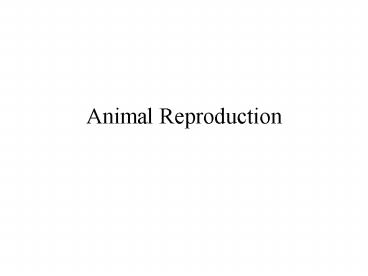Animal Reproduction - PowerPoint PPT Presentation
1 / 28
Title:
Animal Reproduction
Description:
Animal Reproduction * * * * * * * * * * * * * * * * * * * * * * * * Asexual Reproduction Produced genetically identical individuals Examples: hydra, sponges Sexual ... – PowerPoint PPT presentation
Number of Views:124
Avg rating:3.0/5.0
Title: Animal Reproduction
1
Animal Reproduction
2
Asexual Reproduction
- Produced genetically identical individuals
- Examples hydra, sponges
3
Sexual Reproduction
- Fusion of two haploid cells to form a diploid
- Meiosis produces haploid cells
- Mechanism to bring haploid cells together must be
present - Mechanism to create genetic diversity
4
Fertilization
- Haploid sperm and egg unite to form a diploid
zygote
5
External Fertilization
- Sperm spread over egg cells
- Requires water
- Most aquatic animals
- Examples most fish, corals, starfish
- Inefficient
- Spermatophore sperm packaged into capsule
- Some terrestrial animals
- Examples salamanders, scorpions, octopus
6
Internal Fertilization
- Requires copulation
- Most common method for terrestrial animals
- Less sperm and eggs needed
7
Human Reproduction
8
Male Reproductive Organs
9
Male Reproductive Organs
- Testes
- Sperm and testosterone
- Seminal vesicle
- Fructose and prostaglandin
- Prostate
- Basic fluid and sperm motility factors
- Bulbourethral gland
- Mucus
10
Testes
- Produce sperm and testosterone
- Spermatogenesis
- Spermatogonium divides by mitosis
- Meiosis I
- Primary spermatocyte (2n) ? secondary
spermatocyte (1n) - Meiosis II
- Secondary spermatocyte (1n) ? spermatids (1n)
- Differentiation
- Spermatids (1n) ? sperm (1n)
11
Testes
12
Spermatogenesis
13
(No Transcript)
14
Androgens Male Sex Hormones
- Main androgen is testosterone
- Made by the Leydig cells of testes
- Purpose
- Maintain primary and secondary sex
characteristics - Promote sexual behavior and sex drive
- Promote spermatogenesis
15
Sperm Structure
- Acrosome
- Digests egg protective barrier to allow nucleus
to enter egg - Middle Piece
- Mitochondria
- Flagellum
- Microtubules
- Controlled by centrioles
16
Female Reproductive Organs
17
Female Reproductive Organs
- Ovary
- Produce oocytes
- Meiosis I
- Produces hormones (estrogen and progesterone)
- Oviduct (fallopian tube)
- Transmits oocyte to uterus
- Site of fertilization
- Meiosis II
- Uterus
- Zygote implantation
- Placental development
18
Ovary and Oogenesis
- Meiosis I
- Inside ovary
- Primary oocyte (2n) ? Secondary oocyte (1n)
- Meiosis II
- Inside oviduct after fertilization
- Secondary oocyte (1n) ? Ovum (1n)
- Only one egg forms, other products of meiosis
form polar bodies
19
Ovary and Oviduct
20
Ovary and Oogenesis
21
(No Transcript)
22
Female Reproductive Cycle
- Cyclic pattern (average 28 days)
- Menstrual and ovarian cycles
- Controlled by hormones
- Gonadotropin
- LH luteinizing hormone
- FSH follicle-stimulating hormone
- Ovarian hormones
- Estrogen
- Progesterone
23
Menstrual Cycle
- Three phases
- Menstrual flow phase (few days)
- Endometrial surface lost
- Proliferative phase (1-2 weeks)
- Endometrium regenerates
- Secretory phase (2 weeks)
- Endometrium thickens
- Glands develop and secreted glycogen
No embryo implantation
24
Ovarian Cycle
- Two phases
- Follicular phase
- Primary follicle grows into a mature follicle
(Graafian follicle) - Ovulation occurs at the end of this phase
- Luteal phase
- Follicle cells become endocrine tissue and
secrete hormones
25
Menstrual and ovarian cycles
- Menstrual and ovarian cycles run in parallel
26
Ovulation, Fertilization and Implantation
27
Fertilization
- Acrosome discharges enzymes to digest zona
pellucida - Once single sperm enters egg
- Egg releases enzymes that harden zona pellucida
preventing other sperm from entering - Sperm nucleus enters egg and fuses with egg
nucleus
28
Placenta































